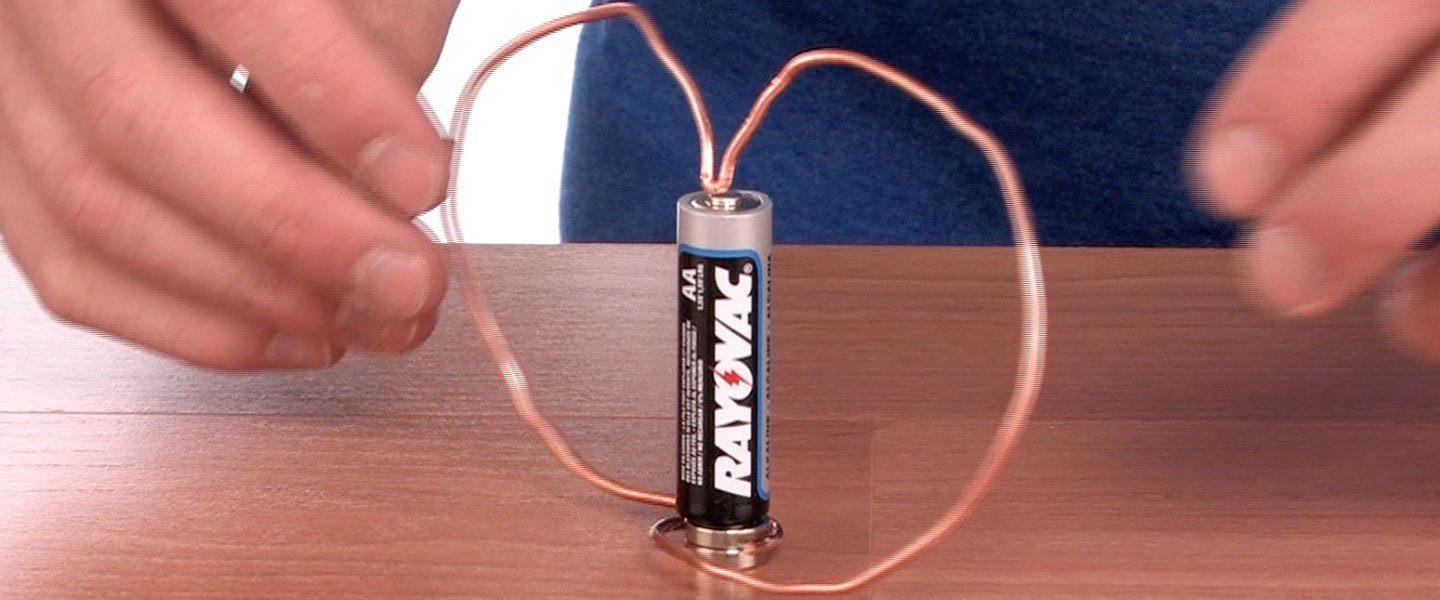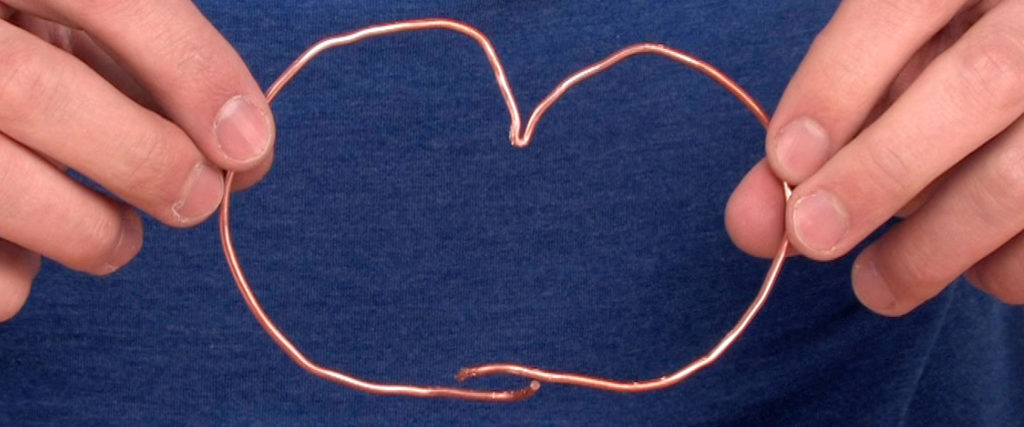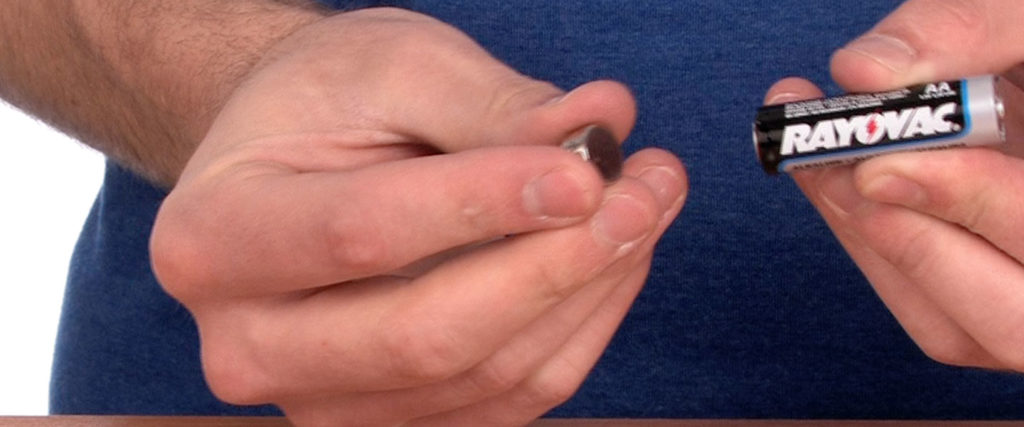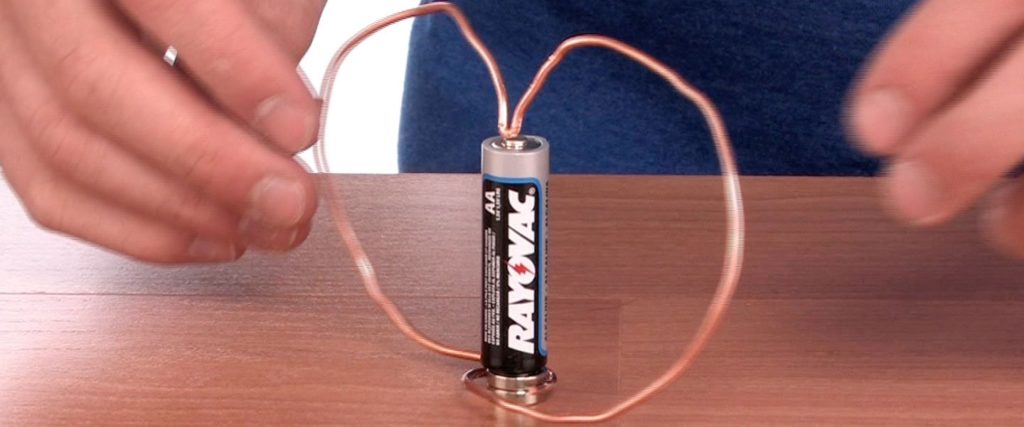LED Throwies
Graffiti Research Lab first introduced us to the awesome throwie idea, and we loved it. Ever since, we’ve been playing around with the idea of […]

Electric motors are devices that turn electrical energy into motion. They are remarkable machines that come in all sizes and do all kinds of work for us. You’d be amazed at just how many motors help you get things done all the time. Motors run on pretty much the same principle: an electric current in a wire moves through a magnetic field producing a force which will spin the wire. Motors can be very complicated but this one is the simplest you can build.

NOTE: The shorter the piece of wire, the faster the rotations will be from your motor. Start with longer wire and shorten it as you get experience bending it.
You’re going to bend the wire into a heart shape that’s a little taller than the battery is high. Find the center of the wire and bend it over on itself at that point. This is the beginning of the heart shape. Bend both wires up and away from this central point and then back down below the base of the battery.
Each end of the wire needs to curve around and brush against the magnets that will be on the bottom of the battery. One end goes one way and the other end goes the other way. Each needs to barely touch the batteries.
You’ll make adjustments in another Step.

Put the two magnets together so one is on top of the other. Attach them to the negative (–) or flat end of the battery and place the battery/magnet setup on the table.

Slide the wire down over the battery and magnets. Here’s where you may need to make some adjustments to the bends. The top point of the wire “heart” (the middle of the wire) needs to balance on the positive pole of the battery. The wire curves from here downward in two directions so the ends close around and lightly touch the magnets. The ends should touch the sides of the magnets without pinching.
Fine-tuning the heart shape may require placing it on the battery/magnet assembly several times, checking for balance, and adjusting the connection made by the two ends of the wire going at the magnets.
When it’s all set, give the wire a tap (if needed) to start it spinning. Way to go!
This is a very simple motor made only with a battery, a copper wire, and a neodymium magnet. It’s a simple motor but, as you’d expect its very inefficient. The charge in the battery is drained quickly and the wire heats up considerably.
The wire connects the positive terminal to the negative terminal of the battery through the magnets and the circuit is complete. That means a current of electrons is flowing in the wire. The presence of the magnets changes things, however. The current actually flows within a magnetic field and when current flows in a magnetic field, it experiences something called the Lorentz force. This force is applied perpendicular to both the current’s direction and the direction of the magnetic field. The Lorentz force is exerted on charged particles (electrons or protons) moving with velocity (that means with a speed and a direction) through electric and magnetic fields at the same time. This force is also at work in the Earth’s magnetosphere where it separates positive (proton) and negative (electron) charges.
It’s important to keep in mind that the current flows in both wires from the top of the battery to the bottom. There’s no short because the wires don’t touch each other at the bottom. The current flows into the magnets where the magnetic field points outward by the wires on the side. When electric current passes through a wire in a magnetic field, magnetic interactions produce torque which moves the wire. The wire and the magnet have magnetic fields around them and these fields exert a force on the wire causing the wire to spin.
You can use any symmetrical shape (one half mirrors the other half) when bending the copper wire. The shape you use needs to connect the positive pole of the battery on top and then loop around the magnets at the bottom of the battery. You could use a heart, a rectangle, a dancer, or a butterfly shape but these will require patience and practice on your part.
Neodymium magnets are extremely strong and should only be used with adult supervision. Two of them coming together can pinch fingers and cause injury. They can’t be easily pulled apart but one can be slid off of another. These magnets should never be put them into your mouth.
The copper wire may become very hot because of the direct connection.